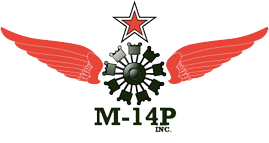Hydraulic Lock Article
TECHNICAL INFORMATION
Sudden Stoppage
Hydraulic Lock Article
V-530 Prop Blade Install & Settings
Centrifugal Advanced Magneto
Introduction to the M-14P
Bent Link Rods
Written by Carl W. Hays ~ 1995
We have had 3 M-14P engines in our shop with bent link rods. These were all liquid lock (hydrauliced) on start-up and the #5 rod was bent. To some extent, we are learning lessons in years past when radial engines were much more common. The problem is simple; the solution is much more complicated.
The compression chamber on the M-14 engine has a volume of about 4 ounces. Anytime there is as much as 3 ounces of a liquid in the chamber there is a potential problem. No, it does not have to be full to cause damage on startup. It will diesel if the compression ratio reaches about 18:1; which it can do with 3 ounces. Pulling the engine through, however, with it nearly full of liquid will not harm the engine.
As you know, if the engine is pulled through by hand before starting, the oil in the cylinders will be forced out of the exhaust valve and the cylinder will be clear enough to start without damage. This is true on the first firing but may not be true as it runs. The intakes on cylinders #4,5 & 6 can pool oil in the bend of the intake tube if the engine is tilted back, as it is on a tailwheel plane. This is why there are drains on these cylinders. We flow-tested 100 weight oil at 70 degrees (Fahrenheit) and found that the oil will be forced into the cylinder at an airflow of 25 cubic feet per minute. This is the airflow at about 15% RPM. If the oil is warmer it will flow at a lower RPM. THERE CAN BE ENOUGH OIL IN THE INTAKE TUBE TO RUIN THE ENGINE EVEN IF THE CYLINDER IS CLEARED BY HAND OR DRAINED.
Pulling the engine through backwards compounds this problem. A manifold drain for these intakes is really necessary if you have a tailwheel aircraft and do not want to pull the drain plugs every start.
WHEN you pull it through by hand is very important. Pull it through at least 3 blades just before starting. Even 5 minutes delay can mean the end of your engine if the conditions are correct. When the engine is cold it should be pulled 15-20 blades and then 3 just before start. If it is warm, then 3 blades are enough.
The lower cylinder valve rocker housings remain full of oil in this engine. Over time, the oil will run between the valve and guide and into the cylinder if the intake valve is open. One of the lower intake valves is always open. We have a drain kit to tie the manifolds together with a quick drain. Leave it open when not running and this works for the intake tubes. When we overhaul these engines, we will modify the cylinder so that it will drain like the Pratt & Whitney 985. These modifications will solve the problem of oil from the intake tubes and rocker housings. Unfortunately, there are two more sources of oil that can get into the cylinder and cause damage. When the engine shuts off, the oil in the top ylinders will drip or run down the rods into the lower cylinders. If it hits the cylinder wall it will eventually run past the rings and into the combustion chamber. If it hits the piston it will pool until it covers the oil holes on the oil ring and then run past the rings and into the combustion chamber. No matter how thoroughly this oil is drained, this oil will be present on start-up unless the spark plugs are pulled and the engine spun at starting RPM using anti-vacuum plug valves. If no other source of oil gets to the combustion chamber this oil will not cause damage but it will cause plug fouling and smoke at the start.
The unpredictable source of oil is from the oil tank and past the oil pump gears and check valve. While the engine manual does not show a check valve, there is one. It is installed in the oil pump housing. Since this valve has only a very weak spring to block oil flow if the pump is not turning it is easily held open by any small particle. It may never happen, but if it does when the engine is hot, you could flow enough oil to fill a combustion chamber in a few minutes. The oil will run into the crank and down to a lower cylinder. This is why it is so important that the prop ALWAYS be pulled through just before starting.
If you are thinking of an oil shutoff valve between the oil tank and the engine, keep thinking. This is not permitted on a standard category aircraft for a very valid safety reason. The consequences of an engine failure after takeoff due to lack of lubrication are always worse than liquid lock damage on starting. I have known several who had it happen even though they thought it was foolproof. The only way that I can see it being safe is to install a double coil, fail maintained, solenoid valve with an indicator light and the start wiring run through a limit switch on the open position.
All of this still leaves us with a solution being to drain the intakes on tailwheel aircraft and pull the engine through just before starting. Pull plugs if there is a lock. This is the way the Russians do it.
May your link rods remain straight forever!
DOWNLOAD HYDRAULIC LOCK ARTICLE
